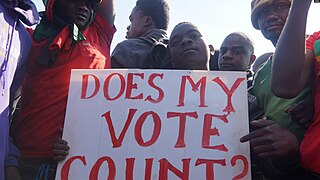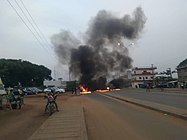The word serhildan describes several Kurdish protests and uprisings since the 1990s that used the slogan "Êdî Bese" ("Enough") against Turkey. Local shops are often closed on the day of demonstrations as a form of protest.

The 2011–2013 protests in Sudan began in January 2011 as part of the Arab Spring regional protest movement. Unlike in other Arab countries, popular uprisings in Sudan had succeeded in toppling the government prior to the Arab Spring in 1964 and 1985. Demonstrations in Sudan however were less common throughout the summer of 2011, during which South Sudan seceded from Sudan, but resumed in force later that year and again in June 2012, shortly after the government passed its much criticized austerity plan.

The 2011 Israeli border demonstrations started on 15 May 2011, to commemorate what the Palestinians observe as Nakba Day. Various groups of people attempted to approach or breach Israel's borders from the Palestinian-controlled territory, Lebanon, Syria, Egypt and Jordan. At least a dozen people were killed when protesters attempted to cross the border from Syria.
The following is an incomplete timeline of events that followed the Bahraini uprising of 2011 from September 2012 onward.

The Syrian Revolution, also known as the Syrian Revolution of Dignity and the Syrian Intifada, was a series of mass protests and civilian uprisings throughout Syria – with a subsequent violent reaction by Ba'athist Syria – lasting from February 2011 to December 2024 as part of the greater Arab Spring in the Arab world. The revolution, which demanded the end of the decades-long Assad family rule, began as minor demonstrations during January 2011 and transformed into large nation-wide protests in March. The uprising was marked by mass protests against the Ba'athist dictatorship of president Bashar al-Assad meeting police and military violence, massive arrests and a brutal crackdown, resulting in hundreds of thousands of deaths and tens of thousands wounded. 13 years after the start of the revolution, the Assad regime fell in 2024 after a series of rebel offensives.

Protests against the 2013 Egyptian coup d'état erupted in July 2013. Immediately following the removal of President Mohamed Morsi by the Egyptian Armed Forces on 3 July 2013 amid demonstrations against Morsi's rule, many protesters amassed near the Rabia Al-Adawiya Mosque to call for Morsi's return to power and condemn the military, while others demonstrated in support of the military and interim government. Deadly clashes such as Rabaa massacre continued for several days, with three particularly bloody incidents being described by officials as "massacres" perpetrated by security forces. During the month of Ramadan, prime minister Hazem al-Beblawy threatened to disperse the ongoing Pro-Morsi sit-ins in Rabaa al-Adaweya square and al-Nahda square. The government crackdown of these protests occurred in a violent dispersal on 14 August 2013. In mid-August, the violence directed by the army towards the protesters escalated, with hundreds killed, and the government declaring a month-long nighttime curfew.

Protests against Faure Gnassingbé have occurred throughout Togo, starting when President Faure Gnassingbé assumed power after the death of his father Gnassingbé Eyadéma in February 2005.
The 2019–2022 Sudanese protests were street protests in Sudan which began in mid-September 2019, during Sudan's transition to democracy, about issues which included the nomination of a new Chief Justice and Attorney General, the killing of civilians by the Rapid Support Forces (RSF), the toxic effects of cyanide and mercury from gold mining in Northern state and South Kordofan, opposition to a state governor in el-Gadarif and to show trials of Sudanese Professionals Association (SPA) coordinators, and advocating the dismissal of previous-government officials in Red Sea, White Nile, and South Darfur. The protests follow the Sudanese Revolution's street protests and civil disobedience of the early September 2019 transfer of executive power to the country's Sovereignty Council, civilian prime minister Abdalla Hamdok, and his cabinet of ministers. Hamdok described the 39-month transition period as defined by the aims of the revolution.

The sentencing of nine Catalan independence leaders in a 2019 trial by the Supreme Court of Spain triggered protests in Catalonia. They were convicted of sedition and other crimes against the Spanish state for their role in the organization of the 2017 Catalan independence referendum.
The 2003 Azerbaijani protests was a series of opposition demonstrations and a violent crackdown against protesters and the 2003 Azerbaijani presidential election results. On the evening of 15 October, anti-government protests erupted, killing 2 when police opened fire with rubber bullets in an attempt to dispel the peaceful sit-ins. These protests were the biggest since the 1998 Azerbaijani presidential election protests.

The 2019 Malawian protests were a series of nationwide rallies and strikes about government pensions, the results of the 2019 Malawian general election and demands for democratic reforms. Anti-presidential unrest was met with police violence against demonstrators. Soon, they used live rounds, tear gas and batons to disperse protesters who protested for three months against the president.

The 2019–2020 Guinean protests, or the Front National pour la Défense de la Constitution (FNDC), were a series of violent protests and mass civil unrest around Guinea against the rule of Alpha Condé that first broke out on 14 October 2019 against constitutional changes. More than 800 were killed in violent clashes and political scenes yet ethnic clashes and this spawned even further rhetoric, while the protesters still resisted despite the harsh repression. After the 2020 Guinean presidential election, widespread unrest took place, leading to the deaths of 27 protesters.
The 2018 Zimbabwean uprising was a series of protests held in 2018 against the results of the 2018 Zimbabwean general election and the regime of Emmerson Mnangagwa. Mass protests against the results of the elections, the deteriorating economic crisis and the national political crisis has also led to 2-days of pro-democracy opposition riots in Harare and other opposition strongholds nationwide. Tens of thousands took to the streets to protest the illegal falsification of the election result and hardships people are facing, and were joined by students, teachers, farmers and workers. Pro-democratic activists also led rallies nationwide in support of the demonstrators in Harare and demanded the end of the regime. Intense clashes and brutal violence ensued in a violent crackdown on protesters. The election unrest turned even deadlier after army officials opened fire on demonstrators, killing 6 and wounding 12+. Civilians were injured in the unrest and small protests were held the day after the protest movement, while 1 was shot dead.
The 2020 Ivorian protests were a series of massive rioting and increasingly violent street demonstrations adding to the growing massive street protests and civil disorder sweeping Ivory Coast. The protests were against the results and the re-run of president Alassane Ouattara. These protests were major anti-government opposition protests, and consisted of supporters of opposition protests in Abidjan and other cities in support of democratic reforms. Protesters used nonviolent tactics but met with intense violence back from the riot police.
The 2018–2019 Comoran protests were a series of mass protests and a deadly uprisings consisting of strikes, riots, demonstrations, and marches in opposition to president Azali Assoumani in Comoros in 2018–2019.
The 1989–1990 protests in Ivory Coast was massive violent demonstrations and a popular uprising that sprang up in Ivory Coast or Côte d'Ivoire in late-1989 to mid-1990, inspired by the 1989–1990 unrest in Benin against the government, low salaries and more.
The 2019 Albanian protests were demonstrations and protests led by the opposition, between February and June 2019, calling for the cancellation of the 2019 Albanian local elections, fresh elections, the resignation of prime minister Edi Rama and his entire cabinet and the installation of a new technocratic government.
The 2009 Gabonese protests was rioting and popular disturbances with immediate unrest and violent opposition-led street demonstrations and growing civil disobedience movement across Port Gentil and Libreville in Gabon after the immediate results of the 2009 Gabonese presidential election was announced. Two were left dead amid the unrest, clashes and fighting between the rival forces. French interference in the actions sparked national outrage, one of the causes if the immediate unrest.
A series of protests in Eswatini against the absolute monarchy and for democratisation began in late June 2021. Starting as a peaceful protest on 20 June, they escalated after 25 June into violence and looting over the weekend when the government took a hardline stance against the demonstrations and prohibited the delivery of petitions. Lower-level unrest and protests continued until summer 2023.

Parliamentary elections were held in Benin on 8 January 2023 to elect all 109 members of the National Assembly. The preliminary results of the election were announced on 11 January. The result was a victory for parties supportive of President Patrice Talon, the Progressive Union and Republican Bloc, which together won 81 of the 109 seats.












